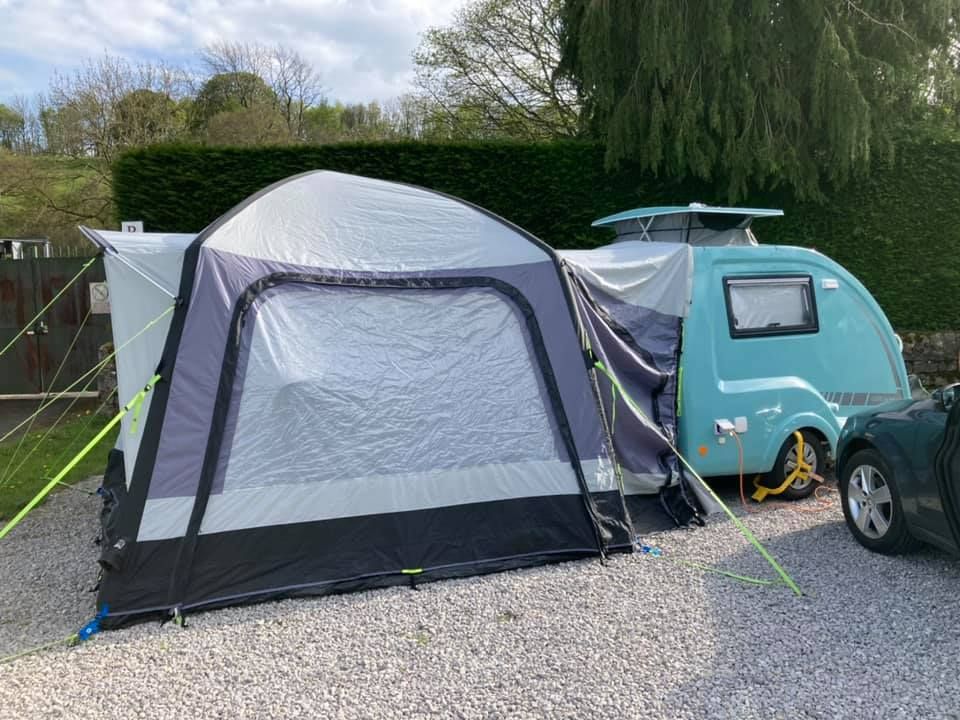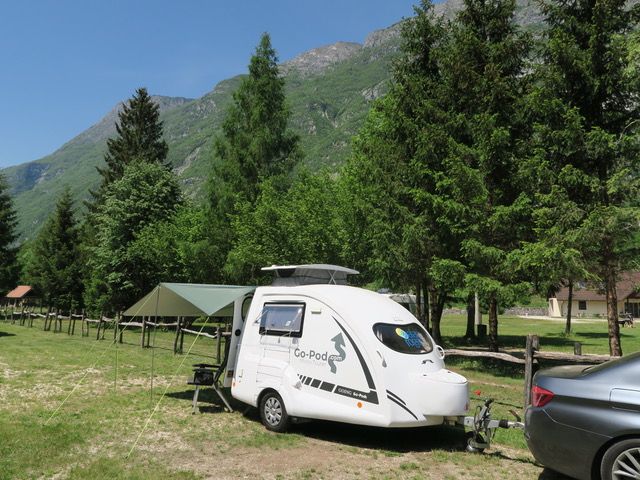Go-Pods vs Camper Vans - how do they compare?

Hitting the open road, travelling without a fixed destination in mind and making any stop your temporary home - that's the dream of camper van ownership sold to us by Hollywood. But is it a feasible idea in the UK, and are there any alternatives that are more suitable?
Pipe dream or reality?
For many leisure-vehicle-novices, camper vans are synonymous with the word "freedom" - the idea of being able to travel to your hearts content, going with the wind and making any location your home. They're often one of the first considerations for anyone actively in the market for a leisure vehicle, looking for a step up from tent camping - but has that dream of total freedom and independence been mis-sold to us?
The reality of the situation is that "wild camping" isn't really a 'done' thing in the UK. In England, wild camping is illegal without the explicit permission of the landowner and many local authorities expressly forbid sleeping in vehicles in laybys, public car parks and public roads, so you'll run the risk of being rudely awoken by a knock from a local police officer asking you to move on. That's not a great recipe for a good nights sleep!
Even in Scotland, which is much more accommodating thanks to the Land Reform Act of 2003, wild camping is only permitted in a "lightweight manner" meaning a tent and other equipment which can be easily packed away and carried by a single person without leaving a noticeable mark on the environment. This of course excludes camper vans, motorhomes and other leisure vehicles.
The long and short of it is that the "camper van dream" depicted in Hollywood movies - living a semi-vagrant lifestyle moving from one location to another in a camper van or RV - just isn't suited to the UK. The USA is multitudes larger than the UK and laws vary widely from state to state (some states alone are even larger than the UK) but for the most part, laws over there are more accommodating of overnight stays in vehicles purely from a practical standpoint, as journeys from one state to another can take days and accommodation isn't always available in rural areas.
How practical are camper vans?
Down to the nitty-gritty bit - just how practical are camper vans? Sure, they're stylish, modern and represent the dream of independence and exploration, but you'll be surprised at just how impractical certain design elements can be.
By far and away, Volkswagen T5 conversions are the most popular type of camper van in the UK - and the world for that matter. The Volkswagen T5 is a light goods van with a sleek design and decently-sized "cargo bay" at the rear that provides an easy template for camper van converters to work with. They're no larger than an SUV and can be stored in garages, driveways or parking spaces which makes them more convenient than larger motorhomes or campervans built on commercial vehicle chassis.
The Volkswagen T5 is the heir-apparent of the classic Volkswagen camper vans immortalised in the golden age of Hollywood cinema, which goes some way to explain their enduring popularity despite the many shortfalls they have in comparison to both larger and smaller leisure vehicles. From the A-Team to more recently critically acclaimed movies like "Nomadland", VW campers hold a special place in Hollywood history and these movies and TV shows do a lot of the legwork for camper van salesmen!
When you start to compare the pros and cons of VW camper van ownership, you'll see it's a fairly one-sided conversation unfortunately:
Pros
- Smart, modern design
- Compact compared to other camper vans
- By far the most popular type of camper van - 1000's of different offerings from converters
- Can be stored at home
- Good second hand market and resale values
Cons
- Designed as a light goods vehicle - not specifically for use in a leisure setting
- Compact nature means limited options for layouts, and certain elements are reduced in size in favour of others
- Another vehicle to run & maintain with associated costs
- Common complaint from owners is that the bed is too small - as a result of converters trying to fit a full kitchen inside
- Often cost £60,000 +
- Versions with lift-up roofs for extra headroom usually start at the £70,000.00 mark
- Less suitable for camping than a purpose-built leisure vehicle or caravan
Cramped & claustrophobic
An unfortunate consequence of working with and living in such a confined space is that many former owners of VW camper vans found them "cramped and claustrophobic" which doesn't provide a comfortable environment for a relaxing holiday.
The actual "living area" (in what is referred to as the "cargo bay" of VW Transporter vans) is only 2.7m long by around 1.7m wide at the widest point. To be able to fit a bed (often formed by a complex and failure-prone system of rollers that use passenger seats to create a base) and a kitchen into a Transporter, most converters are forced to reduce the size of the bed to less than a standard UK double (which is smaller than a US double, for reference) which can become particularly cramped and uncomfortable for 2 people.
Combined with a small kitchen area with limited headroom (particularly in models without custom built lift-up roofs) the result is a cramped space that isn't particularly liveable. Even in models with lift-up roofs, the kitchen units are often at an impractical height requiring you to hunch yourself over to reach the worktops and cupboards.
Another issue is the lack of available storage space in camper vans. As the living space is incredibly limited, owners often find it difficult to manage storage during longer trips with each stop and overnight stay requiring a total re-shuffle.
Price point & running costs
Starting at around £60,000.00 for a new model (potentially rising to up to £100,000.00 depending on features and accessories added) camper vans represent a significant outlay. Once you also factor in the running costs - they are a motorised vehicle, after all - the result is a very expensive holiday option that for many, is the total antithesis of what leisure vehicle ownership should be about - a cost effective, convenient way to explore the country.
Initial cost & depreciation
When buying a new camper van, the largest costs to account for will be the initial outlay to purchase the van and then depreciation in the first three years of ownership.
As above, most new VW camper vans are priced around the £60,000.00 to £70,000.00 mark (with the higher end of that scale being for vans with custom built lift up roofs) which is, when you consider the features and living space that you are actually paying for, a steep price. This is driven in part by the high demand for these vehicles - converters are often signed up to waiting lists for years before receiving stock, as the Transporter variants are still commonly used as delivery vehicles in addition to camper conversions. Volkswagen are able to charge a premium as they are very popular and high demand vehicles.
In terms of depreciation, camper vans depreciate slower than most cars as the total annual mileage (when used exclusively as a leisure vehicle and not for day-to-day use) is far lower than the average car used for commuting or SDP. However, you can still expect to lose 20% of the value within the first few years, which averages at nearly £300/month for a £60,000.00 camper van! When you combine this with vehicle running costs (insurance, MOT, repairs etc) and your actual holiday costs (site fees, food, spending money) you could be looking at a similar cost to a 2 week fully inclusive holiday abroad each year!
Running costs
As camper vans are vehicles, inevitably you will be taking on all of the associated running costs of another vehicle. This includes:
- Road tax
- MOT
- Insurance
- Servicing
- Repairs
- Fuel
The average road tax for a VW camper van is £290.00 per year, which is a considerable cost to account for. This is because, being a light goods commercial vehicle, the vast majority of VW camper vans have diesel engines which are taxed far more harshly than petrol vehicles to provide an incentive for road users to opt for more eco-friendly vehicles with less emissions.
MOT costs are mostly universal throughout the UK and you can expect to pay around £50.00 each year (unless you use a friendly local garage who offer you reduced rates).
Insurance varies widely as with all vehicles, dependent on the make and age of the vehicle, the driver and their accrued no claims bonus, accident history, driving convictions etc. Katie & Adam, VW T5 owners on YouTube (link below) pay over £100.00 per month for their insurance, which amounts to over £1,200.00 per year! In comparison, the average cost for insuring a Go-Pod for a full year is just £180.00.
An average cost for servicing a VW camper van, which will be classed as and charged at commercial vehicle rates by most garages, is around £150.00 - though VW main dealers will charge considerably more.
The cost of repairs will almost entirely depend on how dilligently you maintain your camper van, but being a road vehicle with an engine and all other associated components, repairs will inevitably be higher than a non-motorised leisure vehicle like a caravan.
In terms of fuel costs, most VW camper vans are fairly economical and you can expect around 25mpg (depending how the vehicle is driven) but it's worth considering that unlike with a car & caravan combo, this is permanently locked in as you're unable to swap for a more economical car or EV.
Katie & Adam on YouTube - costs of owning a VW T5 camper van - first year of ownership;
Other considerations
As well as the points outlined above, there are a few other considerations to make when looking to buy a camper van over other leisure vehicles:
- Set up - the set up process for some camper vans can be a long and arduous ordeal. Swapping from "day mode" to "night mode" often involves using a system of rollers to move passenger seats to form a base for the bed.
- Comfort - VW campers have a limited amount of space and often compromise on comfort to fit in more features. Leather upholstered seats are an aesthetically pleasing feature, but are for many too firm to create a comfortable bed and so additional costs will need to be accounted for like mattress toppers and other bedding.
- Versatility - With such a limited amount of space, you'll find there aren't many differing layouts or configurations available. Most commonly, the bed is located at the very rear of the van with the kitchen/living area closest to the cab.
- Ease of use - A very common observation made by VW camper owners is that despite being a seemingly "ready made" solution for camping, that usually isn't the case. To provide enough usable living space many owners purchase "drive-away" awnings that connect to camper vans, which will need to be zipped up and secured whenever you wish to use your van to travel and explore the local area during the day. This is far less practical than a caravan which can be left on site while you use your tow vehicle during the day.
Why are Go-Pods a great alternative to camper vans?

We've received a lot of feedback from Go-Pod owners over the years who either considered a camper van before ultimately opting for a Go-Pod, or those who have owned campers in the past.
Here are a few common observations provided to us by these Go-Pod owners:
They make more financial sense
Let's start with the price point.
A brand new VW T5 camper van will cost you anywhere between £60,000.00 to a whopping £100,000.00! Go-Pods start at £18,495.00, with a top-spec, fully loaded Pod averaging around £24,000.00 - so you could buy nearly 3 top-specification Go-Pods with more features and accessories than a basic level camper van for the same price.
Then, when you consider that there are no running costs to account for other than servicing and replacing tyres or other consumables, and the fact that Go-Pods can be towed by economical cars with small engines or even electric vehicles (with the aerodynamic shape of the shell causing far less wind resistance and drag) your fuel costs will likely be far lower than a camper van.
Also, should you wish to change your car for a more economical model in future, chances are your new vehicle will be able to tow your Go-Pod too - so you can save even more money!
Go-Pods are purpose-built leisure vehicles
Despite their distinctly un-caravan-like appearance, Go-Pods are caravans at heart and have been designed for use as leisure vehicles (though some owners have found other creative uses for them - such as mobile offices, temporary accommodation during house renovations and even mobile bars for family events). A common remark we hear from Go-Pod owners and visitors to the trade shows and events we exhibit at is that there's actually far more usable space in a Go-Pod than a comparable camper van, and that's without taking optional awnings or canopies into account!
At the rear of the Go-Pod, there's a full kitchen complete with sink, tap, hobs and a 12V refrigerator, along with plenty of cupboards and drawers for storage, with a pop-up roof that provides full standing height. The worktops and units are designed for use while standing and provide a much more comfortable experience than camper van kitchen areas.
The wrap-around "dinette style" seating area at the front of the Go-Pod, complete with removable table, comfortably seats up to 4 adults (you can probably fit a couple of small children or pets in there too!) and converts into a full UK double sized bed. The bed is actually slightly wider than a UK king size, providing a comfortable sleeping area that doesn't feel at all cramped for 2 people.
Beneath all 3 seats there are generously-sized storage bunkers to place additional items - most owners use these for storing bedding and other items that don't need to be readily accessible during the day - and either shelves above the windows (Classic model) or overhead lockers (Pioneer model).
They're far more versatile
Whether for short stays or long trips, Go-Pods are well equipped to handle it all. They can be used "as are" for short stays, or you can add optional awnings or canopies to provide extra living space as required.
There's a huge range of accessories to choose from to suit all needs and styles of caravanning. Whether you prefer your Go-Pod fully loaded with all the trimmings or a more minimalist build with the bare essentials, there's something for everyone.
You can also fully customise the appearance of Go-Pods to create a truly unique, bespoke caravan, with the option to choose any shell colour for an additional fee, 4 furniture colours and over 60 fabrics to choose from.
Heading out for the day? No problem!
Another huge advantage that Go-Pods have over camper vans is that you won't need to dismantle your entire setup should you wish to nip out and explore the local area during the day.
If the awning is attached, simply pop your valuables in the Pod, lock the door and head out in your car! And then when you return after a long day of exploring, your Pod is ready and set up for you to relax.
They retain their value
Go-Pods depreciate very slowly compared to camper vans & other caravans, at just 5% per year on average! This makes them a sound financial investment and you can expect to recoup a significant portion of your initial outlay when the time comes to sell.
This is in large part thanks to the one-piece GRP shell that effectively guarantees that water ingress and damp issues will not be a problem. Additionally, Go-Pods are made to order and the demand for Go-Pods has always outweighed supply.
Learn more about Go-Pods
There's a wealth of information about Go-Pods on our website. Here are a few quick links to our most popular pages:
- Specification
- How to order
- Weights & measures
- Guides
- Viewing options
- Events
- Go-Pod Classic model
- Go-Pod Pioneer model
- Accessories & upgrades
You can contact us by calling 01234 816 832, or send us an email at [email protected].


